Chapter: Environmental Biotechnology: Aerobes and Effluents
Aerobes and Effluents
Aerobes and Effluents
The easiest thing that a sewage works is required to treat is
sewage; a large number of industrial or commercial activities produce
wastewaters or effluents which contain biodegradable contaminants and typically
these are discharged to sewers. The character of these effluents varies
greatly, dependent on the nature of the specific industry involved, both in
terms of the likely BOD loading of any organic components and the type of
additional contaminants which may also be present. Accordingly, the chemical
industry may offer wastewaters with high COD and rich in various toxic
compounds, while tannery water provides high BOD with a chromium component and
the textile sector is another high BOD effluent producer, with the addition of
surfactants, pesticides and dyes. Table 6.1 shows illustrative examples of
typical effluent components for various industry sectors.

Table 6.2 shows the
illustrative effluent BOD by industry sector, from which it should be apparent
that the biodegradable component of any given wastewater is itself highly
variable, both in terms of typical values between industries, but also in
overall range. Thus, while paper pulping may present an effluent with a BOD of
25 000 g/m3 , sewage returns the lowest of the BODs quoted.
As might reasonably be
expected from the foregoing discussion, the direct human biological
contribution to wastewater loading is relatively light. A 65 kg person produces
something in the region of 0.1 – 0.5 kg of faeces per day on a wet weight
basis, or between 30 – 60 g of dry solids. The same person also produces around
1 – 1.5 kg of urine per day, with a total mass of dry solids amounting to some
60 – 80 g. Of course, the actual effluent arriving at a sewage works for
treatment contains the nitrogen, phosphorus and other components originally
excreted in the urine or faeces, but in a higher dilution due to flush-ing
water and, often, storm drainage also. Local conditions, climate, details of
the sewer system and water availability are, clearly, all potential factors
affecting this, though a 49:1 ratio of water to solids is fairly typical for
developed nations.
Related Topics